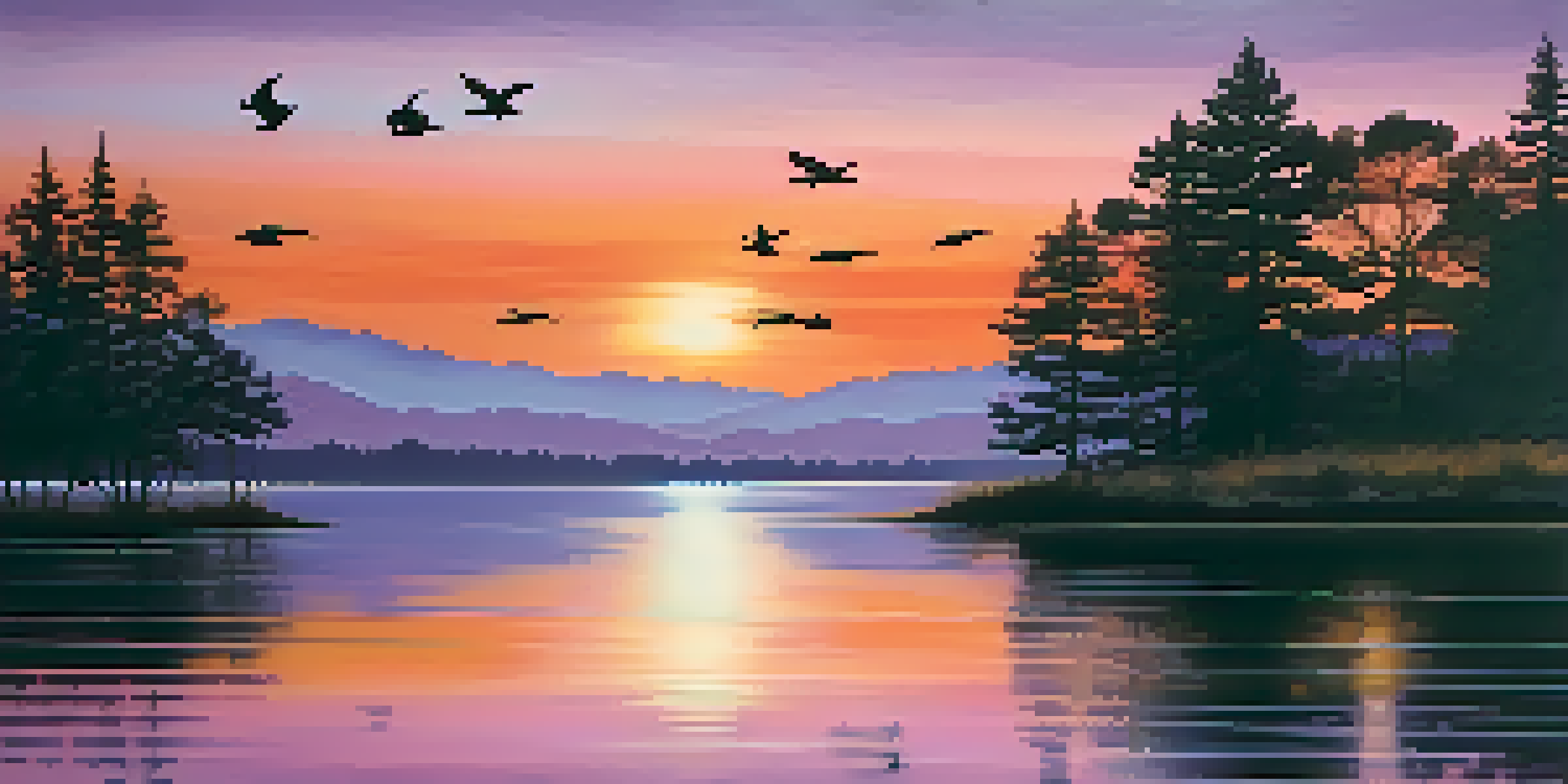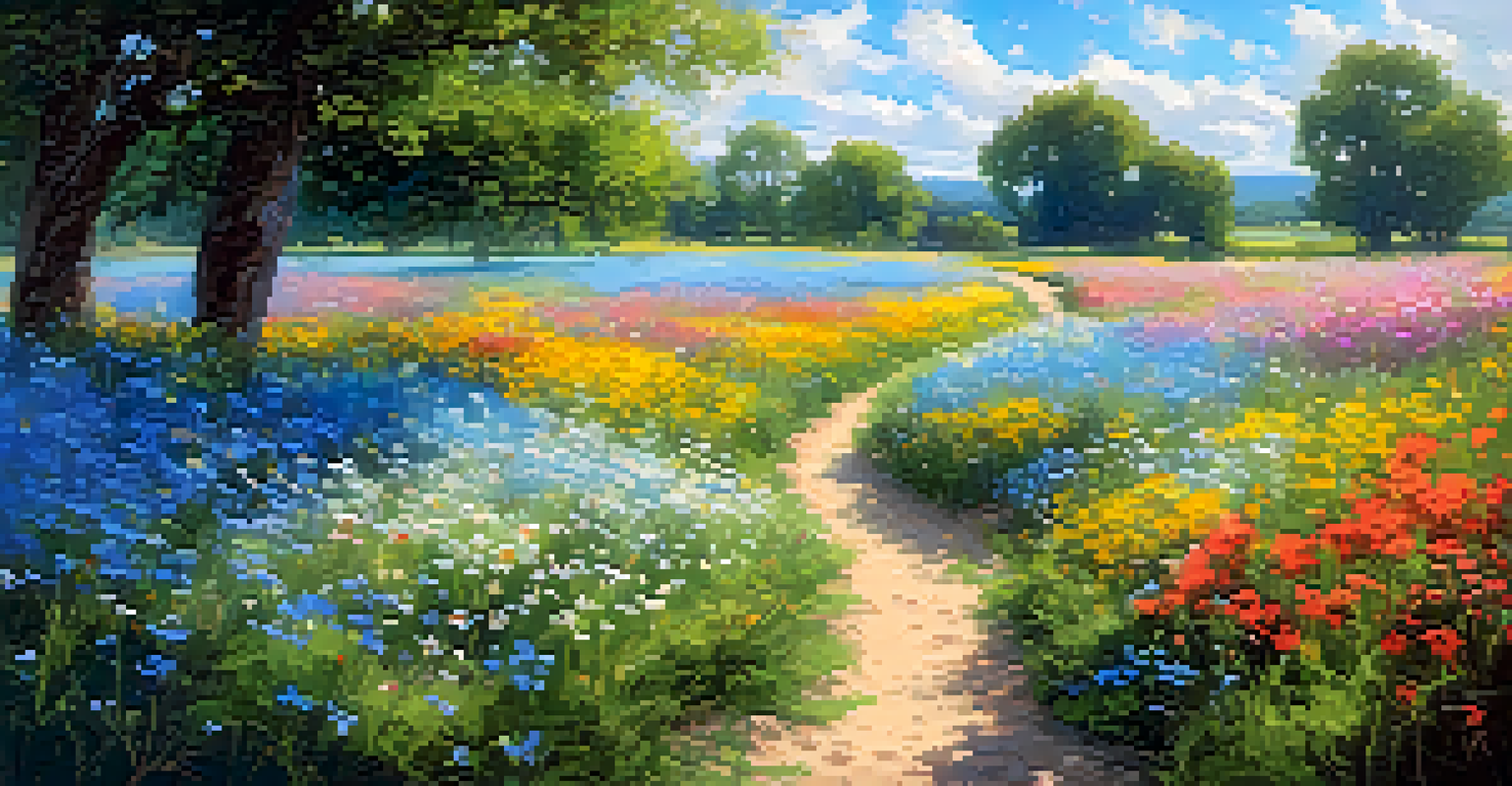The Historical Evolution of Landscape Painting Styles

The Origins of Landscape Painting in Ancient Art
Landscape painting has roots stretching back to ancient civilizations, where natural scenes were often depicted in murals and pottery. Early examples can be found in Egyptian tomb paintings, which portrayed the Nile and surrounding landscapes as a way to depict the afterlife. These early works were not just art; they served practical purposes, reflecting the environment that was vital for survival.
The painter should not paint what he sees, but what will be seen.
As time progressed, artists in ancient Greece and Rome began to incorporate landscapes into their artworks more freely. The Greeks celebrated nature in their sculptures and pottery, while Roman artists created detailed frescoes that showcased idyllic countryside scenes. This shift marked a growing appreciation for the beauty of the natural world and laid the groundwork for future landscape artists.
The transition from depicting mere backgrounds to creating entire compositions based on landscapes marks a significant evolution in art history. This change indicated a budding romanticism towards nature, which artists would continue to explore in subsequent centuries. It set the stage for the flourishing of landscape painting in the medieval period and beyond.
The Medieval Period: Nature in Symbolism
During the medieval period, landscape painting took on a more symbolic role rather than focusing strictly on realism. Artists often incorporated landscapes into religious art, using nature to convey spiritual themes and narratives. This era saw the emergence of stylized landscapes that served as backdrops to biblical scenes, emphasizing the divine connection between God and nature.

The limited perspective and flat, two-dimensional representations dominated this period. Artists like Giotto began to introduce more depth and realism to their landscapes, albeit still in a somewhat abstract form. These early attempts at perspective hinted at the significant transformations that were to come in the Renaissance.
Landscape Art's Historical Roots
Landscape painting originated in ancient civilizations, evolving from practical depictions of nature to a celebrated art form.
Overall, medieval landscapes were less about capturing a moment in time and more about expressing ideas and beliefs. They acted as a bridge between the classical traditions and the more naturalistic approaches that would flourish in the coming centuries, showcasing the evolving relationship between humanity and the environment.
The Renaissance: A Flourishing of Realism
The Renaissance marked a major turning point in the art world, with a renewed interest in realism and the study of nature. Artists like Leonardo da Vinci and Raphael began to incorporate more accurate representations of landscapes into their works, emphasizing perspective, light, and shadow. This period celebrated humanism, encouraging artists to explore the natural world with a fresh perspective.
Art is the most beautiful of all lies.
Innovations in techniques like linear perspective allowed artists to create more immersive landscapes. The inclusion of detailed backgrounds in portraits and religious scenes became common, as artists sought to connect viewers with the environment surrounding their subjects. These changes reflected a growing fascination with the beauty of nature and its intricate details.
The Renaissance also saw the emergence of dedicated landscape painters, such as Claude Lorrain and Salvator Rosa, who focused solely on capturing the essence of the natural world. Their works celebrated the tranquility and splendor of the outdoors, paving the way for future generations to appreciate landscapes as a central theme in art.
The Baroque Era: Drama and Emotion in Landscapes
The Baroque era introduced a sense of drama and emotional intensity to landscape painting. Artists like Peter Paul Rubens and Jacob van Ruisdael employed dynamic compositions, rich colors, and dramatic lighting to evoke feelings of awe and wonder. Their landscapes often depicted turbulent weather and expansive skies, reflecting the emotional states of the time.
This period also saw the development of the 'sublime' in art, where nature was portrayed as both beautiful and terrifying. The artists aimed to capture the vastness and power of the natural world, often placing tiny figures within grand landscapes to emphasize humanity's insignificance. This approach resonated with viewers, offering a profound sense of connection to nature's majesty.
Symbolism in Medieval Landscapes
Medieval landscape painting emphasized symbolic representation, using nature to convey spiritual themes in religious art.
Baroque landscapes also began to incorporate more human elements, such as farms, villages, and people interacting with the environment. This blend of natural beauty and human activity created a narrative quality, inviting viewers to engage with the scenes on a deeper level. The emotional depth of Baroque landscapes set a new standard for artistic expression.
Romanticism: A Deep Connection with Nature
The Romantic period of the late 18th and early 19th centuries emphasized the emotional connection between humans and nature. Artists like Caspar David Friedrich and J.M.W. Turner celebrated the sublime beauty of the natural world, often portraying dramatic landscapes that invoked feelings of awe and introspection. Their works reflected a growing appreciation for nature's power and mystery.
Romantic landscapes were characterized by their use of color and light to convey mood and emotion. Artists experimented with brushwork and composition to create a sense of movement and energy in their scenes. This period also saw a fascination with the untamed aspects of nature, as artists sought to capture the raw beauty of wilderness and the sublime.
Additionally, Romanticism encouraged a personal connection to nature, as many artists began to depict their own experiences and emotions in their work. This shift allowed for a more introspective approach to landscape painting, inviting viewers to reflect on their own relationship with the natural world and its impact on the human experience.
Impressionism: Capturing the Fleeting Moment
The Impressionist movement of the late 19th century revolutionized landscape painting by focusing on capturing the ephemeral qualities of light and atmosphere. Artists like Claude Monet and Pierre-Auguste Renoir employed loose brushwork and vibrant colors to depict scenes in a way that reflected their immediate experience. This approach marked a departure from traditional techniques, emphasizing spontaneity and emotion.
Impressionists often painted en plein air, or outdoors, allowing them to capture the changing conditions of light and weather in real-time. This technique resulted in a unique interpretation of landscapes, where the focus shifted from precise details to the overall impression of a scene. The essence of a moment became more important than accuracy, creating a new way of seeing the world.
Modernism Redefines Landscapes
The 20th century brought new perspectives in landscape painting, moving towards abstraction and emotional expression.
This emphasis on light and color not only transformed landscape painting but also paved the way for future movements like Post-Impressionism and Modernism. The Impressionists' innovative techniques and perspectives encouraged artists to explore their own interpretations of nature, leading to a diverse array of styles in the years to come.
Modernism and Beyond: New Perspectives on Landscapes
As the 20th century unfolded, landscape painting continued to evolve, embracing new ideas and techniques. Modernist artists like Georgia O'Keeffe and Edward Hopper offered fresh perspectives on landscapes, often focusing on abstraction and emotional resonance. This period saw a move away from traditional representations, encouraging artists to explore their own unique visions of the natural world.
The rise of abstract art further transformed landscape painting, with artists like Wassily Kandinsky using color and form to express feelings rather than depict specific scenes. This departure from realism opened the door for diverse interpretations of landscapes, allowing for a more personal and subjective approach to the genre. Artists began to experiment with materials and techniques, pushing the boundaries of what landscape painting could be.

Today, landscape painting encompasses a wide range of styles and approaches, from traditional realism to contemporary abstract interpretations. Artists continue to explore their relationship with nature, reflecting societal changes and environmental concerns through their work. This ongoing evolution demonstrates the enduring significance of landscapes in art and the human experience.